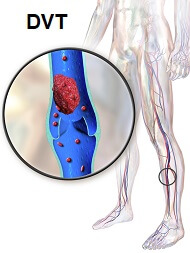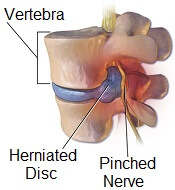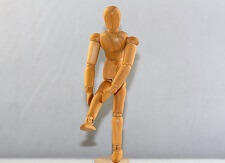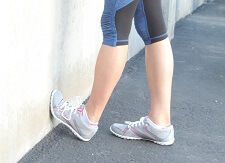- Home
- Knee Pain Diagnosis
- Calf Pain
Calf Muscle Pain
Written By: Chloe Wilson, BSc(Hons) Physiotherapy
Reviewed by: KPE Medical Review Board
Calf muscle pain is a common problem that can make walking, running and jumping difficult and painful.
Pain in the calf region may be due to an injury such as a calf muscle strain or tear, an underlying medical condition or a problem in the nerves or arteries in the lower leg.
Whilst calf muscle pain is often something minor like a grade one calf strain, the problem may not actually be in the muscle itself and could be indicative of a serious problem such as a DVT so should always be treated with caution.
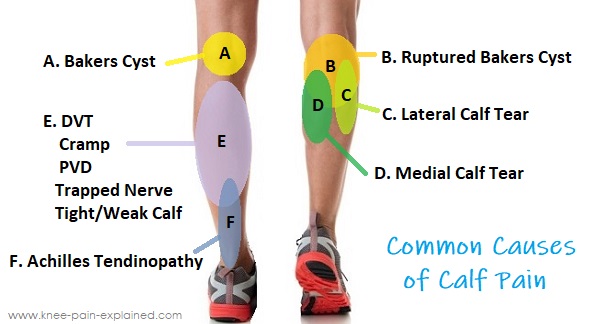
Common Calf Pain Causes
Let's start by looking at the common causes of calf muscle pain, how they present and what causes them. We will then look at when to see your doctor, calf pain treatment and what causes calf pain with specific activities.
1. Calf Strain/Tear
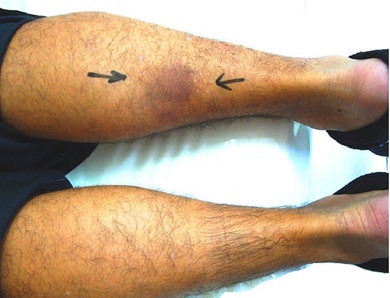
The most common cause of sudden calf pain is a torn calf muscle aka calf strain.
Sudden overstretching of one of the calf muscles, usually gastrocnemius, can cause some of the muscle fibers to tear - the greater the force, the more fibers are likely to tear.
Common activities that cause calf strains include sprinting, suddenly pushing off from a stationary position and quick changes of direction.
The most common symptoms of a calf tear are instant calf muscle pain at the time of injury with associated bruising and swelling. If the muscle tears completely, aka calf rupture, then you will be unable to push up onto your tiptoes.
You can find out more about calf muscle pain from tearing and the best treatment options in this Pulled Calf Muscle article.
2. Calf Cramps
Another common cause of calf muscle pain is calf cramps aka Charley Horse.
Cramp is caused by involuntary spasms in the calf muscles which can be extremely painful.
Calf pain from cramps is usually caused by an imbalance of vitamins/minerals, muscle fatigue, diet, dehydration or muscle imbalance.
Common symptoms of calf cramps include upper calf pain, tightness and spasming in the muscles and difficulty walking. Calf cramps may last anything from a few seconds to a few hours. Cramp is the most common cause of calf pain at night.
You can find out more about calf muscle pain from cramps including the best treatment and prevention options in the Calf Muscle Cramps section.
3. Bakers Cyst
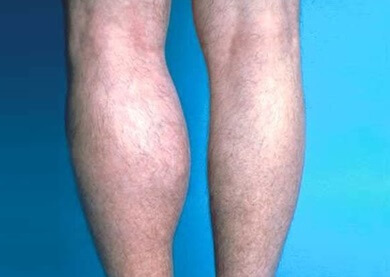
The most common cause of calf muscle pain associated with swelling behind the knee is a Bakers Cyst, aka Popliteal Cyst or Semimembranosus Bursitis.
With a Bakers Cyst, excess fluid collects in the popliteal bursa at the back of the knee. In some cases, the cyst bursts causing the fluid to leak down into the calf muscles.
Common symptoms of a Popliteal Cyst include a pocket of swelling behind the knee, often resembling a squashy orange, upper calf muscle pain that gets worse with activity and in some cases bruising around the ankle.
You can find out more about the causes, symptoms and treatment options in the Baker Cyst section.
4. Achilles Tendinopathy
The most common cause of lower calf pain that may extend down towards the foot is Achilles Tendonitis.
With Achilles tendinopathy, there is inflammation, degeneration or tearing in the achilles tendon which attaches the calf muscles to the foot.
Achilles tendonitis is usually caused by repetitive stress or overloading through the tendon from jumping, running, muscle imbalance or altered foot biomechanics.
Common symptoms of achilles tendonitis include lower calf pain, thickening in the achilles tendon, pain when pushing up onto your tiptoes and ankle stiffness.
You can find out all about the best treatment options in the Achilles Tendonitis section on our sister site.
Other Causes of Calf Pain
So we've looked at the most common causes of calf muscle pain, but there are a few other less common causes of pain in the calf region.
1. Deep Vein Thrombosis (DVT)
A deep vein thrombosis can be a very serious cause of lower leg pain. A DVT is the formation of a blood clot in a deep vein, usually in the calf or thigh.
A DVT requires IMMEDIATE medical attention as it reduces the blood flow to the foot, and there is the risk that the blood clot could break off and travel through the bloodstream to the heart or lungs which can cause a heart attack or pulmonary embolus.
The common signs of a DVT are intense calf pain, redness, warmth and swelling in the calf region. The calf pain often gets worse if your dorsiflex your foot (pull your toes up towards you).
DVT’s often develop after surgery or periods of inactivity e.g. plane journeys, and there can be a genetic link.
2. Trapped Nerve
Compression of the nerves of the lower leg can cause calf pain, pins and needles and numbness in the lower leg.
The nerve compression may be coming from the lower
back where the nerve originates from, or at any point along the nerve itself.
Trapped nerves are usually accompanied by changes in sensation such as pins and needles, tingling or numbness and lower leg pain often spreads.
Any symptoms of nerve compression should be
checked out by your doctor. You can find out more in the nerve pain section on our sister site.
3. Muscle Imbalance
Muscle weakness and tightness is a common cause of calf muscle pain. Weak muscles will tire quickly if you are on your feet for prolonged periods of time, so it is important to work on both strength and endurance.
If the calf is tight, there is greater risk of calf injury due to the increased tension, making stretching exercises vital.
Exercises are the best way to combat this and it important to get the right balance of strengthening and stretching exercises - visit the calf strengthening and calf stretching exercises sections for a whole range of exercises that will help combat this cause of calf pain and reduce the risk of calf injury.
4. Peripheral Vascular Disease (PVD)
Also known as peripheral artery disease, this is when there is a narrowing in the arteries which can slow blood flow. If this happens in the lower leg, it can cause calf muscle pain.
Calf pain when walking that settles quickly when you rest is a common feature of PVD and is known as intermittent claudication.
Peripheral Vascular Disease is commonly associated with smoking, diabetes, high cholesterol levels and high blood pressure. In severe cases, the foot and lower leg may change colour – this warrants immediate medical attention.
When To See Your Doctor With Calf Pain?
Most cases of calf pain will settle down within a few days of rest a simple home treatments but sometimes it is worth seeing your doctor.
See Your Regular Doctor If:
- you have moderate calf pain
- symptoms are getting worse or not improving after 7 days
- altered sensation in the calf or foot
- regular or severe calf cramps
Seek Urgent Medical Attention If:
- severe calf pain or swelling
- obvious deformity in the lower leg
- you cannot bear weight through the leg
- the calf is red, hot and tender to touch
- sudden intense calf pain with no obvious cause
- you have difficulty breathing
Calf Muscle Pain Treatment
Calf pain treatment will depend on the underlying cause of the pain but usually starts by following PRICE principles:
- Protect: the calf from further damage e.g. use crutches
- Rest: from aggravating activities for a few days but then it is important to get going again
- Ice: regularly applying ice packs to the sore calf muscle will help to reduce pain and inflammation
- Compression: wearing a tubigrip compression bandage helps to reduce calf swelling and support the area
- Elevation: prop your leg up on cushions or pillows when resting so your calf is higher than your heart. This helps to reduce calf swelling
After a few days of following PRICE treatment your calf pain should start to improve and you can start doing more. Treatment will depend on the underlying cause of your calf pain:
- Calf Tear Treatment
- Bakers Cyst Treatment
- Calf Cramps Treatment
- Achilles Tendonitis Treatment
- Calf Strengthening Exercises
- Calf Stretches
You may find taking over-the-counter medication helpful to reduce calf pain and inflammation. Your doctor may also recommend a course of physical therapy as part of your calf muscle pain treatment. It is rare to need surgery with calf pain unless there is a severe injury.
Calf Muscle Pain With Activities
Calf muscle pain will come on at different times and during different activities depending on what is wrong.
1. Calf Pain When Walking
Calf pain when walking after an injury is common, particularly with a pulled calf muscle. But what if you haven't actually injured your calf?
Calf muscle pain when walking without an injury is usually the result of reduced blood flow, and therefore lack of oxygen, to the calf muscles and usually settles down quickly with rest.
If you get calf pain when walking everyday that settles within a few minutes of resting, it can be a sign of intermittent claudication. Lower leg pain that persists even after resting may indicate a more serious problem such as severe peripheral vascular disease.
2. Calf Pain In Runners
Calf pain running is typically caused by the muscles being overloaded which can lead to a calf tear. Any sudden increase in running activities, be it distance, speed, surface, or the introduction of speed or uphill work, can overload the calf muscles resulting in pain.
A lack of strength or endurance in the leg muscles is a common cause of calf pain in runners. A good test is to stand on 1 leg and push up onto your tiptoes then slowly lower back down. If you can do this 30 times on each leg, it indicates good calf strength and endurance. If not, you would benefit from do calf strengthening work.
3. Calf Muscle Twitching
A twitching sensation in the calf muscles often indicates benign fasciculation syndrome, a condition due to a harmless disorder of the nerves that activate the calf muscles. The twitching usually stops when you use the lower leg muscles e.g. walking, but will often return when you rest.
Calf muscle twitching can also be the first sign of cramp, or that you have overworked the muscles. In rare instances, the twitching may indicate a more serious condition such as Lyme Disease, Multiple Sclerosis or Motor Neurone Disease.
4. Calf Pain At Night
Calf muscle pain at night is often caused by nocturnal cramps which will usually wake you up. They tend to settle fairly quickly if you stretch the calf muscles.
Calf pain at night can also indicate restless leg syndrome, where you have an overwhelming urge to keep moving your legs. It is very common to be more aware of pain at night as there are less distractions around.
5. Calf Muscle Tightening
Tight calf muscles are usually the result of overuse such as long distance running, particularly if you don't warm up and cool down properly. Muscle tightness can also develop after an ankle or calf muscle injury.
Stretching exercises focusing on both gastrocnemius and soleus, when done daily are usually the best way to overcome calf muscle tightening.
6. Calf Muscle Knot
The technical term for calf muscles knots is myofascial trigger points. This is where a small area of muscle fibres and the underlying fascia tighten forming small lumps in the muscle, like a knot.
They may only hurt when you press on there, or in some cases they can cause pain at anytime for no obvious reason. Knots typically develop after a calf muscle injury but can also be related to poor posture, stress and prolonged inactivity. They usually respond well to stretches.
Another possible cause of a lump in the calf is that excess scar tissue has formed following a calf tear. Specific calf tear treatment such as cross friction massage and ultrasound helps to prevent and treat this.
7. Sudden Calf Pain
The most common cause of sudden calf pain is a calf muscle strain, where part of the gastrocnemius or soleus muscles are overstretched causing it to tear.
Calf tears typically occur during sports and may be accompanied by bruising and swelling. Starting calf muscle tear treatment early helps to speed up healing and reduce the risk of reinjury or long term problems.
Calf cramps can also develop very suddenly, either during activity or at rest.
Anatomy Of The Calf Muscles
The calf is the area on the back of the leg between the knee and the ankle.
It is made up of two muscles collectively known as the triceps surae. Triceps surae simply means “three-headed calf (muscle)”. It comprises of a pair of muscles, gastrocnemius and soleus.
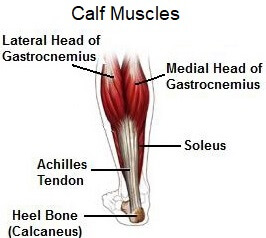
The gastrocnemius muscle has two-heads which arise from either side of the bottom of the femur just above the knee joint. It is a superficial muscle, meaning it forms the top layer just below the skin.
The soleus muscle runs deep to (underneath) gastrocnemius and arises from the top of the tibia, just below the knee joint.
The two muscles join together around mid-calf level to form the Achilles tendon which twists and attaches the calf muscles to the back of the heel.
The triceps surae muscles work together to plantarflex the
foot i.e. pull the foot downwards and
stabilise the ankle. The calf muscles are
particularly important in controlling and executing the push-off phase of
walking and running.
Safety Advice
Episodes of calf muscle pain should always be assessed by your doctor to ensure it is nothing serious such as a DVT which requires immediate attention.
Pay particular attention to the signs for a DVT: redness, swelling, warmth and pain around the calf.
Also, sudden calf or lower leg pain that is worse at night or makes it difficult to walk warrants immediate medical attention.
You may also be interested in the following articles:
- Pain Behind The Knee
- Front Knee Pain
- Knee Pain Running
- Knee Pain Going Down Stairs
- Knee Pain Diagnosis
- Nerve Pain In Leg & Foot
Related Articles
References
1. British Journal of Sports Medicine: Overview of exercise induced lower leg pain. January 2011
2. Physiotherapy Journal: Mechanical calf pain in a 23-year-old male due to dynamic functional entrapment of the popliteal artery. September 2005
3. Harvard Health Publishing: When walking makes your legs hurt - Four conditions for leg pain causes that can affect you when walking. August 2018
Page Last Updated: January 16th, 2025
Next Review Due: January 16th, 2027
